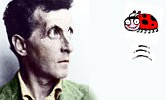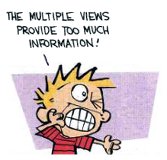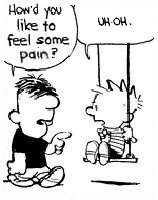Seeing and being
Preface
 This is an essay on the “hard problem” of consciousness. If we focus on visual consciousness for simplicity, this is often said to be the problem of explaining how the everyday phenomenon we call seeing “arises” from the brain. But I have never liked this way of phrasing the problem because it strikes me that we have a poor grasp (to begin with) of the everyday phenomenon of seeing itself. —What is this thing we call seeing? So, in the essay, I explore instead the prior question of what we suppose the everyday phenomenon of seeing even to be—a question just as hard, but one which I find to be considerably more fruitful. And the only decent answer I can come up with suggests that a certain form of “neutral monism” may be the true relation between mind and body. Written in 2014.
This is an essay on the “hard problem” of consciousness. If we focus on visual consciousness for simplicity, this is often said to be the problem of explaining how the everyday phenomenon we call seeing “arises” from the brain. But I have never liked this way of phrasing the problem because it strikes me that we have a poor grasp (to begin with) of the everyday phenomenon of seeing itself. —What is this thing we call seeing? So, in the essay, I explore instead the prior question of what we suppose the everyday phenomenon of seeing even to be—a question just as hard, but one which I find to be considerably more fruitful. And the only decent answer I can come up with suggests that a certain form of “neutral monism” may be the true relation between mind and body. Written in 2014.
 This is an essay on the “hard problem” of consciousness. If we focus on visual consciousness for simplicity, this is often said to be the problem of explaining how the everyday phenomenon we call seeing “arises” from the brain.
This is an essay on the “hard problem” of consciousness. If we focus on visual consciousness for simplicity, this is often said to be the problem of explaining how the everyday phenomenon we call seeing “arises” from the brain.
8. The genesis of the concept of seeing
The omnivisual being is meant to help us understand why we have the concept of seeing over and above the concept of being – why we distinguish the two.
It may be obvious at this point what my answer is going to be. —For if an omnivisual being has no essential need to distinguish seeing from being, then the reason why we need to do so must have something to do with the fact that we are not omnivisual.
In other words, the fact that we do not see everything must be what explains why we need the concept of seeing. More precisely, it explains why we need to distinguish something’s being the case from our seeing it to be the case.
This is the basic answer that I will defend. Before spelling it out fully, it may be useful to address one lingering issue. This will also help us later.
I suggested that an omnivisual being would have no essential need to distinguish seeing from being. As with the case of pain, however, this claim is good only “in the first instance,” for we can easily think of more intricate contexts in which an omnivisual being might have a genuine use for the distinction, after all.
For example, the world might contain other beings with normal vision, with which our all-seeing being is compelled to interact.
To make sense of their behaviour, he may need to admit a general proposition like:
and to grasp the conditions under which they can “see” what he “always sees” – e.g., their eyes need to be open, and they must be facing the right way, etc.
So their presence compels him to distinguish the seeing of a tree (say) from the being of the tree, a distinction he might not otherwise have drawn. Having made the distinction, he can now appreciate that, unlike other mortals, he sees everything – a thought he might not otherwise have entertained.
The point of this example should not be overstated. It simply describes a case where an omnivisual being may have a genuine need to distinguish seeing from being – where, in saying this, I am relying for the moment on our “pre-theoretic” grasp of the distinction. I have yet to clarify the nature of the distinction – in case this was not clear.
Let’s consider a second example of an omnivisual being who is accustomed to wielding the distinction.
Imagine discovering one day that your powers of vision are “gradually expanding” (more science fiction) until you find yourself eventually to have become omnivisual.
The entire process takes the whole day, say. In this case, you might well realize – in “real time” – that you had become omnivisual. At the end of the day, you would be able to think, “Holy cow, I see everything” – but, of course, only because, having previously been normal, you were already familiar with the distinction between seeing and being.
These examples show that an omnivisual being is not barred outright from grasping and wielding the distinction between seeing and being. But they also suggest that some “stage-setting” is required for this to happen. The distinction has to be learnt, or otherwise acquired, in some way or other. In the first-example, it was post-acquired; in the second, pre-acquired. Either way, the distinction is not handed out for free, not even to a superhero.
Notice that similar remarks apply to the familiar case of (bodily) pain. We noted previously that, for most people, the feeling of pain is simply the pain – no distinction is ordinarily here drawn.
But why then do people often speak of (say) “feeling” a pain in their back?
Why do they speak as if the feeling was an act that was directed upon an object called pain – only to subsequently deny that any such distinction was really being made? —What explains the act-object language if no corresponding distinction was intended?
The answer, I think, is that most people are simply confused about the phenomenon of pain, vacillating between a Wittgensteinian view, on which pain is just a feeling, and an act-object model, according as it suits their purposes.
Thus, in many cases of pain, e.g., stubbing one’s toe, there is no obvious need to distinguish the being of the pain from the feeling. So the Wittgensteinian view is here very natural. But then we also understand – for example – that other people sometimes don’t know about our pains, and vice versa. (My guess is that this has to be learnt – it is probably not obvious to a child.) A case like this encourages us to distinguish the being of the pain (in my toe) and the feeling of it (on your part), and an act-object model has now begun to creep in.
Likewise, a little boy who cries out in pain is not likely to be wielding an act-object model, especially if he is not familiar with the idea of doing something to “numb” the pain. But once he latches on to this idea, e.g., from repeated visits to a dentist, then the thought of doing something so as “not to feel” the pain can begin to get a purchase. (Another way for the act-object model to creep in.)
 So while we mostly begin with the Wittgensteinian view, it is possible to “graduate” to the act-object model by appreciating that there are situations in which the being of a pain can meaningfully be prised apart from the feeling. And, once you have the distinction, nothing stops you from applying it to your own case and saying (e.g.) that you feel a pain in your back – i.e., even as you might ordinarily deny that the pain was anything more than your feeling of it.
So while we mostly begin with the Wittgensteinian view, it is possible to “graduate” to the act-object model by appreciating that there are situations in which the being of a pain can meaningfully be prised apart from the feeling. And, once you have the distinction, nothing stops you from applying it to your own case and saying (e.g.) that you feel a pain in your back – i.e., even as you might ordinarily deny that the pain was anything more than your feeling of it.
Indeed our tacit acknowledgement of the act-object model is also what allows us to say such things as, “We always feel our own bodily pains,” which thought might not even be possible if we really made no distinction between the being of a pain and its feeling.
Considerably more may be said about this process of “cleaving” the being of a pain apart from its feeling. Philosophers remain greatly torn over the phenomenon of pain and there are numerous issues to untangle. For the moment, we must get back to the phenomenon of seeing. The essential thing we need here is the initial point, viz., that an omnivisual being would have no immediate need – i.e., absent the sort of “learning opportunities” described above – to distinguish seeing from being. He would be unaccustomed to the distinction, just as an untutored boy would be unused to the act-object conception of pain.
This is the essential thing because it points the way forward. We are now ready to investigate the following proposal: the reason why we need the concept of seeing, over and above the concept of being – why we are compelled to distinguish the two – has something to do with the fact that we are not omnivisual beings.
The omnivisual being is meant to help us understand why we have the concept of seeing over and above the concept of being – why we distinguish the two.
It may be obvious at this point what my answer is going to be. —For if an omnivisual being has no essential need to distinguish seeing from being, then the reason why we need to do so must have something to do with the fact that we are not omnivisual.
In other words, the fact that we do not see everything must be what explains why we need the concept of seeing. More precisely, it explains why we need to distinguish something’s being the case from our seeing it to be the case.
Note. Likewise, the more general distinction between “mind” and “world” may originate in the fact that we do not know everything, i.e., that we are not omniscient. I will consider this generalization later.
This is the basic answer that I will defend. Before spelling it out fully, it may be useful to address one lingering issue. This will also help us later.
I suggested that an omnivisual being would have no essential need to distinguish seeing from being. As with the case of pain, however, this claim is good only “in the first instance,” for we can easily think of more intricate contexts in which an omnivisual being might have a genuine use for the distinction, after all.
For example, the world might contain other beings with normal vision, with which our all-seeing being is compelled to interact.
To make sense of their behaviour, he may need to admit a general proposition like:
There are “things” which these other beings sometimes cannot “see.”
and to grasp the conditions under which they can “see” what he “always sees” – e.g., their eyes need to be open, and they must be facing the right way, etc.
So their presence compels him to distinguish the seeing of a tree (say) from the being of the tree, a distinction he might not otherwise have drawn. Having made the distinction, he can now appreciate that, unlike other mortals, he sees everything – a thought he might not otherwise have entertained.
The point of this example should not be overstated. It simply describes a case where an omnivisual being may have a genuine need to distinguish seeing from being – where, in saying this, I am relying for the moment on our “pre-theoretic” grasp of the distinction. I have yet to clarify the nature of the distinction – in case this was not clear.
Let’s consider a second example of an omnivisual being who is accustomed to wielding the distinction.
Imagine discovering one day that your powers of vision are “gradually expanding” (more science fiction) until you find yourself eventually to have become omnivisual.
The entire process takes the whole day, say. In this case, you might well realize – in “real time” – that you had become omnivisual. At the end of the day, you would be able to think, “Holy cow, I see everything” – but, of course, only because, having previously been normal, you were already familiar with the distinction between seeing and being.
These examples show that an omnivisual being is not barred outright from grasping and wielding the distinction between seeing and being. But they also suggest that some “stage-setting” is required for this to happen. The distinction has to be learnt, or otherwise acquired, in some way or other. In the first-example, it was post-acquired; in the second, pre-acquired. Either way, the distinction is not handed out for free, not even to a superhero.
Notice that similar remarks apply to the familiar case of (bodily) pain. We noted previously that, for most people, the feeling of pain is simply the pain – no distinction is ordinarily here drawn.
But why then do people often speak of (say) “feeling” a pain in their back?
Why do they speak as if the feeling was an act that was directed upon an object called pain – only to subsequently deny that any such distinction was really being made? —What explains the act-object language if no corresponding distinction was intended?
The answer, I think, is that most people are simply confused about the phenomenon of pain, vacillating between a Wittgensteinian view, on which pain is just a feeling, and an act-object model, according as it suits their purposes.
Thus, in many cases of pain, e.g., stubbing one’s toe, there is no obvious need to distinguish the being of the pain from the feeling. So the Wittgensteinian view is here very natural. But then we also understand – for example – that other people sometimes don’t know about our pains, and vice versa. (My guess is that this has to be learnt – it is probably not obvious to a child.) A case like this encourages us to distinguish the being of the pain (in my toe) and the feeling of it (on your part), and an act-object model has now begun to creep in.
Likewise, a little boy who cries out in pain is not likely to be wielding an act-object model, especially if he is not familiar with the idea of doing something to “numb” the pain. But once he latches on to this idea, e.g., from repeated visits to a dentist, then the thought of doing something so as “not to feel” the pain can begin to get a purchase. (Another way for the act-object model to creep in.)

Indeed our tacit acknowledgement of the act-object model is also what allows us to say such things as, “We always feel our own bodily pains,” which thought might not even be possible if we really made no distinction between the being of a pain and its feeling.
Considerably more may be said about this process of “cleaving” the being of a pain apart from its feeling. Philosophers remain greatly torn over the phenomenon of pain and there are numerous issues to untangle. For the moment, we must get back to the phenomenon of seeing. The essential thing we need here is the initial point, viz., that an omnivisual being would have no immediate need – i.e., absent the sort of “learning opportunities” described above – to distinguish seeing from being. He would be unaccustomed to the distinction, just as an untutored boy would be unused to the act-object conception of pain.
This is the essential thing because it points the way forward. We are now ready to investigate the following proposal: the reason why we need the concept of seeing, over and above the concept of being – why we are compelled to distinguish the two – has something to do with the fact that we are not omnivisual beings.
Menu
 What’s a logical paradox?
What’s a logical paradox? Achilles & the tortoise
Achilles & the tortoise The surprise exam
The surprise exam Newcomb’s problem
Newcomb’s problem Newcomb’s problem (sassy version)
Newcomb’s problem (sassy version) Seeing and being
Seeing and being Logic test!
Logic test! Philosophers say the strangest things
Philosophers say the strangest things Favourite puzzles
Favourite puzzles Books on consciousness
Books on consciousness Philosophy videos
Philosophy videos Phinteresting
Phinteresting Philosopher biographies
Philosopher biographies Philosopher birthdays
Philosopher birthdays Draft
Draftbarang 2009-2024  wayback machine
wayback machine
 wayback machine
wayback machine




